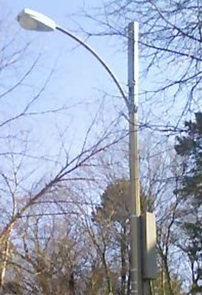Greenburgh Town Board Rejects NextG's Bid to Install DAS in Residential Neighborhoods
- Thursday, 02 August 2012 07:59
- Last Updated: Thursday, 02 August 2012 08:08
- Published: Thursday, 02 August 2012 07:59
- Hits: 10834
 In an 18 page decision available here , the Town of Greenburgh decided to reject NextG’s current application to install distributed antenna systems (DAS) in residential locations. NextG, which was acquired by Crown Castle on April 20th, has also applied for zoning considerations in multiple municipalities throughout the country, including Scarsdale (For background information, click here or here , and also read a letter from a concerned resident here).
In an 18 page decision available here , the Town of Greenburgh decided to reject NextG’s current application to install distributed antenna systems (DAS) in residential locations. NextG, which was acquired by Crown Castle on April 20th, has also applied for zoning considerations in multiple municipalities throughout the country, including Scarsdale (For background information, click here or here , and also read a letter from a concerned resident here).
The decision, handed down on July 24th by members of the Town Board, rejects the current application made by NextG, but leaves the window open for an amended application. After reviewing all of the relevant documents and laws, the town found two violations of the Greenburgh Antenna Zoning Law that could not be ignored. The law, put into place in 1996, was made in order to maintain the character and property values of the municipality and calls for the use of non-residential antennas before new residential ones.
Although the law has many sections, the applicable violations were to the burden of proof that “The facility is needed to provide coverage to an area of the unincorporated area of the Town that currently has inadequate coverage,” and “The facility is the minimum height and aesthetic intrusion necessary to provide coverage.”
As to the first stipulation, NextG argued that their possible clients had inadequate coverage in areas of the town and therefore passed the burden of proof. However, NextG is solely a utility, and its clients are not putting up the DAS. So, the Town Board argued that the facilities are speculative and not actually filling any void in coverage. Furthermore, the Second Circuit decided that any service gap must be decided from the perspective of “users in a given area.” Since Greenburgh residents are not complaining, no void exists.
In regards to the second passage, since NextG’s operations are speculative, it was unable to prove that the amount of space used by its antennas was appropriate. The proposed DAS have the ability to accommodate two carriers. Since NextG does not have two carriers lined up, this size may be unnecessary.
While both of these violations are apparent, the board still had to avoid certain Federal regulations in order to reject the application. For one, NextG attempted to utilize the Federal Telecommunications Act, Chapter 5, Section 332. While the act yields most power to local zoning codes, it provides several caveats. First, it notes that local zoning may not regulate based on environmental effects of antennas if the FCC has permitted them. Since the stated violations are not based on such effects, they stand.
Second, the act states that zoning laws cannot stop wireless service companies from providing service. However, Greenburgh does allow for wireless installations, just not in residential areas or in the right of way.
Third, the act denies local zoning from “discriminating among providers of functionally equivalent services.” However, it does allow for such discrimination based on aesthetic concerns. Thus, the local zoning objections stand up to Section 332.
NextG also tried to utilize passages in Section 253 of the same act. However, the statutes in the section specifically do not override those of Section 332. So, as long as the local zoning complies with section 332, the rejection is valid.
NextG still can continue its fight. If NextG finds legal problems with the ruling based on provisions in Federal or State laws, they have the right to sue the Town. And, the Town Board ruling also allows for an amended application. However, any such application must include a service gap from the perspective of users, which cannot be solved through the use of antennas in nonresidential areas, and solve the issue of maintenance or removal upon physical damage or possible obsoleteness.
While Greenburgh has finished its initial dealings with NextG and Crown Castle, Scarsdale’s conflict still continues. However, the decision in Greenburgh could expedite the process. Scarsdale’s dealings with NextG have been moving at a snail’s pace. The last Planning Board meeting on the subject was on May 7, and the two parties have no spoken in a while. “Scarsdale has not heard back from Crown Castle,” noted Joseph Van Eaton, partner at D.C based law firm Best, Best, & Krieger and Scarsdale Village’s lawyer on the matter. “Maybe they were waiting for Greenburgh themselves.”
Although the Federal laws are mostly applicable to Scarsdale’s case, Scarsdale and Greenburgh have different local zoning codes. A decision by Scarsdale must use the local codes and make sure that they do not violate and of the previously mentioned Federal acts or any other applicable laws.
Many residents hope that Scarsdale will be successful in attempts to deny the application. “I hope no antennas are put up,” stated one Greenacres Ave. resident. “I’m fine with the service just the way it is.”
Zach Edelman is a 2012 graduate of Scardsale High School who will attend college in September.










